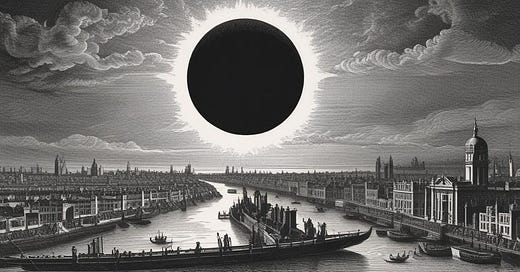Five... Things about the 1715 Solar Eclipse in London
'A Description of the Passage of the Shadow of the Moon over England'
Hi and welcome to your weekend newsletter… ☀️
This week it’s a newsletter driven by celestial envy, with my whatsapp groups flooded with eclipse-watching content from people in Montreal and New York. So I’ve been reading up on London’s solar eclipses of centuries past, and decided the 18th century delivers up my favourite - and arguably the most momentous - London eclipse on record: the first solar eclipse visible from London for centuries, arriving as the Enlightenment swell of excitement for studying the skies really started to crescendo.
On 22 April, 1715 (though this was before Britain adopted the Gregorian calendar, so that’s 3 May, 1715 in today’s money…) for 3 minutes and 33 seconds, London was plunged into darkness.
The path of the total solar eclipse passed through Cornwall, sweeping upwards on a northeastern arc, and eventually reaching London towards the southwestern edge of its path. And it marked the rise of an astronomical celebrity, Edmond Halley, who managed to hitch his fortunes to the passage of various celestial bodies - and his correct prediction of them - so successfully that the entire 1715 eclipse is, in a real coup of personal branding, now generally known as Halley’s Eclipse.
The historical context
‘The like Eclipse having not for many ages been seen in the Southern Parts of Great Britain, I thought it not improper to give the Publick an Account thereof, that the sudden darkness, wherein the Starrs will be visible about the Sun, may give no surprize to the People, who would, if unadvertized, be apt to look upon it as Ominous and to interpret it as portending evill to our Sovereign Lord King George and his Government, which God preserve…’
- Edmond Halley, 1715.
In 1714 King George I inherited the throne, at a time when general doubt about the role of the monarchy was on the rise, plus quite a lot of specific doubt about this monarch in particular.
Halley’s annotation to his eclipse map here, as well as being some excellent political manoeuvring - you don’t get to be appointed Astronomer Royal in 1719 by sounding a bit Jacobite-y - speaks to a real sense during this period that science and superstition were warring for the minds of the British people, to a degree that could determine the fate of kings and nations.
Halley predicted the timing of the eclipse to within four minutes accuracy. He predicted the path of it to within 20 miles accuracy: potentially a big disappointment if you were sitting in York with your eclipse-watching kit at the ready, but on a solar scale not bad. The kind of accuracy that, he hoped, would help convince people to look for the physical laws behind it rather than omens.





